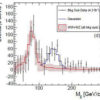How a bicycle stays upright while moving has always been something of a mystery to science, with a vague cocktail of gyroscopic effects being the accepted explanation. Now, however, scientists from Cornell University and the Delft University of Technology have determined the complex interplay of design characteristics that make a bike stay upright. The findings, […]






